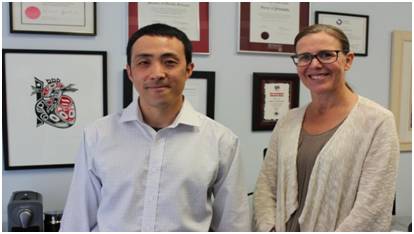|
|
检索丨刘金淑
翻译丨陈燕琼
审核丨陈志锦
根据阿尔伯塔省大学康复医学院研究人员进行的一系列研究,接受心脏旁路手术后30天内,肥胖患者感染风险更高。研究团队分析了地方性登记册中56722名患者的数据,以检查冠状动脉搭桥术(CABG)手术和经皮冠状动脉介入术(PCI,也称为冠状动脉血管成形术)后体重指数(BMI)与各种结局之间的关系。
康复科学博士后研究员Tasuku Terada最近在加拿大肥胖峰会上介绍了一系列的研究,他们发现, 体重指数大于30的患者行心脏搭桥手术后报告出现感染的可能性是体重指数正常患者的1.9倍。这方面我们需要了解更多,以改善心脏病肥胖患者的临床疗效。
此外,发表在《加拿大心脏病杂志》上的另一项研究发现,接受PCI手术的患者中88%为肥胖患者,而接受CABG手术的患者中肥胖患者只占55%。PCI是一种非外科手术,由于心脏血管斑块积聚而进行人工扩张。医生把一个小支架放在血管内防止血管再次狭窄。
Terada说CABG手术后的感染风险或许可以解释为什么肥胖患者更多选择接受PCI手术。他解析道:“我们需要研究CABG手术后感染风险更高的原因,以及为什么更多的肥胖患者选择接受PCI手术,是否因为他们适合做这个手术,或是术后的感染风险应该作为医务人员做决定的一个考虑因素。”
手术感染意味着患者住院时间的增加,导致医疗费用和医疗资源使用的增加。了解风险和潜在的结果能够帮助卫生保健提供者和患者在治疗和资源使用上做出更明智的选择。因此,进一步的调查将有助于研究人员开发出能降低感染风险的工具,并确保患者得到适当的治疗。例如,手术后胸部粘合剂的使用。
资料来源:阿尔伯塔大学

原文:
Risk of Infection Higher for Patients With Obesity After Bypass Surgery

Tasuku Terada (left), postdoctoral research fellow at the University of Alberta's Faculty of Rehabilitation Medicine, and his supervisor, Mary Forhan. Courtesy of University of Alberta
Patients with obesity have a higher risk of infection within 30 days after receiving heart bypass surgery, according to a series of studies conducted by University of Alberta researchers at the Faculty of Rehabilitation Medicine.
The team analyzed data from 56,722 patients in the provincial registry to examine associations between body mass index (BMI) and various outcomes following coronary artery bypass grafting (CABG) surgery and percutaneous coronary intervention (PCI), also known as coronary angioplasty.
"Compared to patients with normal BMI, we found that patients with BMI greater than 30 were 1.9 times more likely to report infections after bypass surgery," said Tasuku Terada, a rehabilitation science postdoctoral research fellow who recently presented the series of studies at the Canadian Obesity Summit. "A better understanding is needed in order to improve clinical outcomes for patients with obesity and heart disease."
In addition, another study in the series published in the Canadian Journal of Cardiology found that 88 per cent of patients who received PCI were classified as obese, compared to 55 percent of the patients who received CABG. PCI is a non-surgical procedure that opens up narrowed arteries in the heart due to plaque buildup. The physician places a small stent to keep the artery open and help to prevent re-narrowing.
Terada says the risk of infection following CABG may explain why patients with obesity are more likely to receive PCI.
"We need to look at why there is more infection following CABG and whether more patients with obesity are receiving PCI because they should be, or because the risk is a factor in the decision made by healthcare professionals," he says.
Postsurgical infection means an increase in the length of stay at the hospital for patients, resulting in increased medical costs and use of resources. Knowing the risks and potential outcomes can help health-care providers and patients make more informed choices on treatment and better use of resources.
Mary Forhan, obesity expert and assistant professor in occupational therapy at the Faculty of Rehabilitation Medicine, believes that further investigation will help researchers develop tools to help decrease the risk of infection, and to ensure that patients are receiving proper care.
"For example, are the chest binders that are used after surgery the right size and are they working the right way?" she says. "Our team is currently looking at the re-design of postsurgical chest binders so that patients have better outcomes following bypass surgery."
Source: University of Alberta

图文编辑:独白
审稿:孙庆芬 赵静
|
|